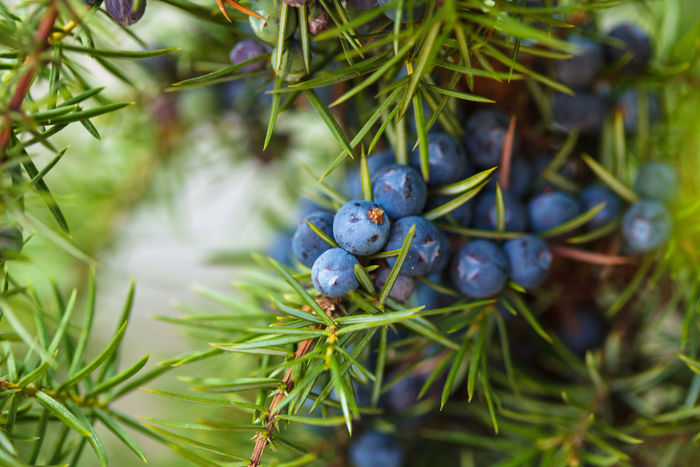Juniper berries
Juniper berries are the fruit of the woody plant or bush with the same name, the juniper (Juniperus communis), although there are subspecies and different varieties.
They are not actual berries but female cones shaped like round berries that appear green at first and turn darker when maturing. Once dried and ready to eat, they show their characteristic mixture of dark blue and purple colour.
The juniper can be found in mountainous zones, especially in the cold parts of Europe, Asia and North America.
It is used in the making process of gin as well as in aromatherapy and perfumery because of its essential oil.
In cooking, juniper berries are used to aromatize meat dishes, especially strong meats like game. They are used in German traditional dishes like sauerkraut and to make marinades, sauces and the like.
Juniper berries are a bit sour, with citric and sweet tones. They can be used fresh and dried, but their use should be moderate as they provide a very strong flavour. They should be crushed before being used so that they can release their full potential.
-
Type of dish
- Beers
- Cocktails
- Breakfasts and brunch
- Burguers
- Juices, milkshakes and beverages
- Shellfish
- Bread and pastries
- Pizzas, patty
- Dessert
- Pasta
- Sándwich
- Pastries
- Finger foods
- Ice creams and sorbets
- Legumes
- Salads
- Eggs
- Patty
- liqueur
- Harvard plate
- Main course
- Meats
- Fish
- Birds
- Vegetables
- Soups and creams
- Rices
- Coffee, chocolate and infusion
- Cheeses
- Appetizers and canapes
- Temperature
- Cuisine type
- Additional culinary preparation
- Conservation technique
- Seasonal recipes
-
- Aromatic herbs
- Beverages
- Big game hunt
- Bread and pastries
- Canned goods and pickles
- Cereals
- Condiments, spices and additives
- Cooked, salted, preserved and cold meats
- Dried fruits and nuts
- Dry pulses
- Edible oils and vinegars
- Eggs and derivatives
- Feathered game hunt
- Fish cuts
- Fishes
- Insects
- Kitchen and bakery tecniques
- Kitchen and bakery utensils
- Meat cuts
- Meats
- Milk, cream and derivatives
- Mushrooms
- Offal
- Pasta, rice, flour and derivatives
- Poultry
- Seafood
- Service techniques
- Service utensils
- Vegetables cuts
- Vegetables, fruits, tubers and seaweed

